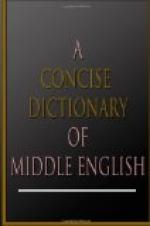The material used has been carefully revised by both authors, so that they must be held to be jointly responsible for the final form in which the whole is now offered to the public.
NOTE ON THE PHONOLOGY OF MIDDLE-ENGLISH.
One great difficulty in finding a Middle-English word in this, or any other, Dictionary is due to the frequent variation of the symbols denoting the vowel-sounds. Throughout the whole of the period to which the work relates the symbols i and y, in particular, are constantly interchanged, whether they stand alone, or form parts of diphthongs. Consequently, words which are spelt with one of these symbols in a given text must frequently be looked for as if spelt with the other; i.e. the pairs of symbols i and y, ai and ay, eA and ey, oA and oy, uA and uy, must be looked upon as likely to be used indifferently, one for the other. For further information, the student should consult the remarks upon Phonology in the Specimens of English (1150 to 1300), 2nd ed., p. xxv. For those who have not time or opportunity to do this, a. few brief notes may perhaps suffice.
The following symbols are frequently confused, or are employed as equivalent to each other because they result from the same sound in the Oldest English or in Anglo-French:—
/* i,y;—ai, ay;—ei, ey;—oi, oy;—ui, uy.
a, o;—a, A|, e, ea;—e, eo, ie;—o, u, ou; —(all originally short).
a, A|, ea, e, ee;—e, ee, eo, ie;—o, oo, oa;— u, ou, ui;—(all long). */
These are the most usual interchanges of symbols, and will commonly suffice for practical purposes, in cases where the cross-references fail. If the word be not found after such substitutions have been allowed for, it may be taken for granted that the Dictionary does not contain it. As a fact, the Dictionary only contains a considerable number of such words as are most common, or (for some special reason) deserve notice; and it is at once conceded that it is but a small hand-book, which does not pretend to exhibit in all its fulness the extraordinarily copious vocabulary of our language at an important period of its history. The student wishing for complete information will find (in course of time) that the New English Dictionary which is being brought out by the Clarendon Press will contain all words found in our literature since the year 1100.
Of course variations in the vowel-sounds are also introduced, in the case of strong verbs, by the usual ‘gradation’ due to their method of conjugation. To meet this difficulty in some measure, numerous (but not exhaustive) cross-references have been introduced, as when, e.g. ‘Bar, bare’ is given, with a cross-reference to Beren. Further help in this respect is to be had from the




